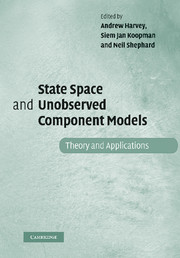Book contents
- Frontmatter
- Contents
- Preface
- Acknowledgements
- Part I State space models
- Part II Testing
- Part III Bayesian inference and bootstrap
- Part IV Applications
- 10 Measuring and forecasting financial variability using realised variance
- 11 Practical filtering for stochastic volatility models
- 12 On RegComponent time series models and their applications
- 13 State space modelling in macroeconomics and finance using SsfPackin S+Finmetrics
- 14 Finding genes in the human genome with hidden Markov models
- References
- Author index
- Subject index
11 - Practical filtering for stochastic volatility models
Published online by Cambridge University Press: 06 January 2010
- Frontmatter
- Contents
- Preface
- Acknowledgements
- Part I State space models
- Part II Testing
- Part III Bayesian inference and bootstrap
- Part IV Applications
- 10 Measuring and forecasting financial variability using realised variance
- 11 Practical filtering for stochastic volatility models
- 12 On RegComponent time series models and their applications
- 13 State space modelling in macroeconomics and finance using SsfPackin S+Finmetrics
- 14 Finding genes in the human genome with hidden Markov models
- References
- Author index
- Subject index
Summary
Abstract
This paper provides a simulation-based approach to filtering and sequential parameter learning for stochastic volatility models. We develop a fast simulation-based approach using the practical filter of Polson, Stroud and Müller (2002). We compare our approach to sequential parameter learning and filtering with an auxiliary particle filtering algorithm based on Storvik (2002). For simulated data, there is close agreement between the two methods. For data on the S&P 500 market stock index from 1984–90, our algorithm agrees closely with a full MCMC analysis, whereas the auxiliary particle filter degenerates.
Introduction
Filtering and sequential parameter learning for stochastic volatility (SV) have many applications in financial decision making. SV models are commonly used in financial applications as their dynamics are flexible enough to model observed asset and derivative prices. However, many applied financial decision making problems are sequential in nature such as portfolio selection (e.g. Johannes, Polson and Stroud (2002b)) and option pricing. These applications require filtered estimates of spot volatility and sequential parameter estimates to account for estimation risk. In this paper, we provide a simulation-based approach for volatility state filtering that also incorporates sequential parameter learning. The methodology is based on the practical filter of Polson, Stroud and Müller (2002). Unlike previous simulation-based filtering methods, for example Kim, Shephard and Chib (1998) in the SV context, our algorithm incorporates sequential parameter learning within Markov chain Monte Carlo (MCMC).
Many authors have considered the problem of simulation-based filtering with known static parameters.
- Type
- Chapter
- Information
- State Space and Unobserved Component ModelsTheory and Applications, pp. 236 - 247Publisher: Cambridge University PressPrint publication year: 2004
- 9
- Cited by



